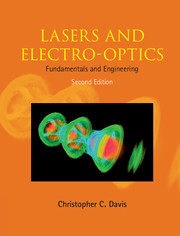Book contents
- Frontmatter
- Contents
- Preface to the Second Edition
- 1 Electromagnetic waves, light, and lasers
- 2 Optical frequency amplifiers
- 3 An introduction to two practical laser systems
- 4 Optical resonators containing amplifying media
- 5 Laser radiation
- 6 Control of laser oscillators
- 7 Optically pumped solid-state lasers
- 8 Gas lasers
- 9 Molecular gas lasers I
- 10 Molecular gas lasers II
- 11 Tunable lasers
- 12 Semiconductor lasers
- 13 Passive optical systems
- 14 Periodic optical systems, resonators, and inhomogeneous media
- 15 The optics of Gaussian beams
- 16 Optical fibers and waveguides
- 17 The optics of anisotropic media
- 18 The electro-optic and acousto-optic effects and modulation of light beams
- 19 Introduction to nonlinear processes
- 20 Wave propagation in nonlinear media
- 21 Detection of optical radiation
- 22 Coherence theory
- 23 Laser applications
- Appendix 1 Optical terminology
- Appendix 2 The ´-function
- Appendix 3 Black-body radiation formulas
- Appendix 4 RLC circuits
- Appendix 5 Storage and transport of energy by electromagnetic fields
- Appendix 6 The reflection and refraction of a plane electromagnetic wave at a boundary between two isotropicmedia of different refractive indices
- Appendix 7 The vector differential equation for light rays
- Appendix 8 Symmetry properties of crystals and the 32 crystal classes
- Appendix 9 Tensors
- Appendix 10 Bessel-function relations
- Appendix 11 Green's functions
- Appendix 12 Recommended values of some physical constants
- Index
- References
2 - Optical frequency amplifiers
Published online by Cambridge University Press: 05 June 2014
- Frontmatter
- Contents
- Preface to the Second Edition
- 1 Electromagnetic waves, light, and lasers
- 2 Optical frequency amplifiers
- 3 An introduction to two practical laser systems
- 4 Optical resonators containing amplifying media
- 5 Laser radiation
- 6 Control of laser oscillators
- 7 Optically pumped solid-state lasers
- 8 Gas lasers
- 9 Molecular gas lasers I
- 10 Molecular gas lasers II
- 11 Tunable lasers
- 12 Semiconductor lasers
- 13 Passive optical systems
- 14 Periodic optical systems, resonators, and inhomogeneous media
- 15 The optics of Gaussian beams
- 16 Optical fibers and waveguides
- 17 The optics of anisotropic media
- 18 The electro-optic and acousto-optic effects and modulation of light beams
- 19 Introduction to nonlinear processes
- 20 Wave propagation in nonlinear media
- 21 Detection of optical radiation
- 22 Coherence theory
- 23 Laser applications
- Appendix 1 Optical terminology
- Appendix 2 The ´-function
- Appendix 3 Black-body radiation formulas
- Appendix 4 RLC circuits
- Appendix 5 Storage and transport of energy by electromagnetic fields
- Appendix 6 The reflection and refraction of a plane electromagnetic wave at a boundary between two isotropicmedia of different refractive indices
- Appendix 7 The vector differential equation for light rays
- Appendix 8 Symmetry properties of crystals and the 32 crystal classes
- Appendix 9 Tensors
- Appendix 10 Bessel-function relations
- Appendix 11 Green's functions
- Appendix 12 Recommended values of some physical constants
- Index
- References
Summary
Introduction
When an electromagnetic wave propagates through amedium stimulated emissions increase the intensity of the wave, while absorptions diminish it. The overall intensity will increase if the number of stimulated emissions can be made larger than the number of absorptions. If we can create such a situation then we have built an amplifier that operates through the mechanism of stimulated emission. This laser amplifier, in common with electronic amplifiers, has useful gain only over a particular frequency bandwidth. Its operating frequency range will be determined by the lineshape of the transition, and we expect the frequency width of its useful operating range to be of the same order as the width of the lineshape. It is very important to consider how this frequencywidth is related to the various mechanisms by which transitions between different energy states of a particle are smeared out over a range of frequencies. This line broadening affects in a fundamental way not only the frequency bandwidth of the amplifier, but also its gain. A laser amplifier can be turned into an oscillator by supplying an appropriate amount of positive feedback. The level of oscillation will stabilize because the amplifier saturates. Laser amplifiers fall into two categories, which saturate in different ways. A homogeneously broadened amplifier consists of a number of amplifying particles that are essentially equivalent, whereas an inhomogeneously broadened amplifier contains amplifying particles with a distribution of amplification characteristics.
Homogeneous line broadening
All energy states, except the lowest energy state of a particle (the ground state) cover a range of possible energies.
- Type
- Chapter
- Information
- Lasers and Electro-opticsFundamentals and Engineering, pp. 33 - 71Publisher: Cambridge University PressPrint publication year: 2014



